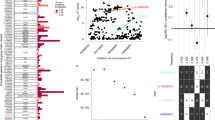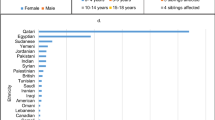Abstract
CBLB was evaluated as a candidate gene for type 1 diabetes (T1D) susceptibility based on its association with autoimmunity in animal models and its role in T-cell costimulatory signaling. Cblb is one of the two major diabetes predisposing loci in the Komeda diabetes-prone (KDP) rat. Cbl-b, a ubiquitin ligase, couples TCR-mediated stimulation with the requirement for CD28 costimulation, regulating T-cell activation. To identify variants with possible effects on gene function as well as haplotype tagging polymorphisms, the human CBLB coding region was sequenced in 16 individuals with T1D: no variants predicted to change the amino-acid sequence were identified. Seven single-nucleotide polymorphism (SNP) markers spanning the CBLB gene were genotyped in multiplex T1D families and assessed for disease association by transmission disequilibrium testing. No significant evidence of association was obtained for either individual markers or marker haplotypes.
This is a preview of subscription content, access via your institution
Access options
Subscribe to this journal
Receive 6 digital issues and online access to articles
$119.00 per year
only $19.83 per issue
Buy this article
- Purchase on Springer Link
- Instant access to full article PDF
Prices may be subject to local taxes which are calculated during checkout

Similar content being viewed by others
References
Rich SS . Mapping genes in diabetes. Genetic epidemiological perspective. Diabetes 1990; 39: 1315–1319.
Rich SS, Concannon P . Challenges and strategies for investigating the genetic complexity of common human diseases. Diabetes 2002; 51: S288–S294.
Mein CA, Esposito L, Dunn MG et al. A search for type 1 diabetes susceptibility genes in families from the United Kingdom. Nat Genet 1998; 19: 297–300.
Cox NJ, Wapelhorst B, Morrison VA et al. Seven regions of the genome show evidence of linkage to type 1 diabetes in a consensus analysis of 767 multiplex families. Am J Hum Genet 2001; 69: 820–830.
Nerup J, Pociot F . A genomewide scan for type 1-diabetes susceptibility in Scandinavian families: identification of new loci with evidence of interactions. Am J Hum Genet 2001; 69: 1301–1313.
Pociot F, McDermott MF . Genetics of type 1 diabetes mellitus. Genes Immun 2002; 3: 235–249.
Bell GI, Horita S, Karam JH . A polymorphic locus near the human insulin gene is associated with insulin-dependent diabetes mellitus. Diabetes 1984; 33: 176–183.
Nerup J, Platz P, Andersen OO et al. HL-A antigens and diabetes mellitus. Lancet 1974; 2: 864–866.
Ueda H, Howson JM, Esposito L et al. Association of the T-cell regulatory gene CTLA4 with susceptibility to autoimmune disease. Nature 2003; 423: 506–511.
Kristiansen OP, Larsen ZM, Pociot F . CTLA-4 in autoimmune diseases—a general susceptibility gene to autoimmunity? Genes Immun 2000; 1: 170–184.
Yokoi N, Kanazawa M, Kitada K et al. A non-MHC locus essential for autoimmune type I diabetes in the Komeda diabetes-prone rat. J Clin Invest 1997; 100: 2015–2021.
Yokoi N, Komeda K, Wang HY et al. Cblb is a major susceptibility gene for rat type 1 diabetes mellitus. Nat Genet 2002; 31: 391–394.
Chiang YJ, Kole HK, Brown K et al. Cbl-b regulates the CD28 dependence of T-cell activation. Nature 2000; 403: 216–220.
Bachmaier K, Krawczyk C, Kozieradzki I et al. Negative regulation of lymphocyte activation and autoimmunity by the molecular adaptor Cbl-b. Nature 2000; 403: 211–216.
Nistico L, Buzzetti R, Belgian Diabetes Registry et al. The CTLA-4 gene region of chromosome 2q33 is linked to, and associated with, type 1 diabetes. Hum Mol Genet 1996; 5: 1075–1080.
Chen X, Levine L, Kwok PY . Fluorescence polarization in homogeneous nucleic acid analysis. Genome Res 1999; 9: 492–498.
Orita M, Iwahana H, Kanazawa H, Hayashi K, Sekiya T . Detection of polymorphisms of human DNA by gel electrophoresis as single-strand conformation polymorphisms. Proc Natl Acad Sci USA 1989; 86: 2766–2770.
Sobel E, Lange K . Descent graphs in pedigree analysis: applications to haplotyping, location scores, and marker-sharing statistics. Am J Hum Genet 1996; 58: 1323–1337.
Abecasis GR, Cookson WO . GOLD–graphical overview of linkage disequilibrium. Bioinformatics 2000; 16: 182–183.
Spielman RS, McGinnis RE, Ewens WJ . Transmission test for linkage disequilibrium: the insulin gene region and insulin-dependent diabetes mellitus. Am J Hum Genet 1993; 52: 506–516.
Kruglyak L, Daly MJ, Reeve-Daly MP, Lander ES . Parametric and nonparametric linkage analysis: a unified multipoint approach. Am J Hum Genet 1996; 58: 1347–1363.
Lernmark A, Ducat L, Eisenbarth G et al. Family cell lines available for research. Am J Hum Genet 1990; 47: 1028–1030.
Acknowledgements
We thank Suna Onengut-Gumuscu for assistance with TDT and LD analyses, V Anne Morrison and Lemuel Navarro for assistance with nucleotide sequencing, and Mary West for manuscript preparation. This work was supported by grants from the NIH (DK46635) and JDRF (1-2001-433) to PC and from the Ministry of Education, Culture, Sports, Science and Technology of Japan to SS and NY. RK was supported by a Genome Training Grant (NHGRI, T32 HG00035).
Author information
Authors and Affiliations
Corresponding author
Rights and permissions
About this article
Cite this article
Kosoy, R., Yokoi, N., Seino, S. et al. Polymorphic variation in the CBLB gene in human type 1 diabetes. Genes Immun 5, 232–235 (2004). https://doi.org/10.1038/sj.gene.6364057
Received:
Revised:
Accepted:
Published:
Issue Date:
DOI: https://doi.org/10.1038/sj.gene.6364057
Keywords
This article is cited by
-
Inhibition of CBLB protects from lethal Candida albicans sepsis
Nature Medicine (2016)
-
Elucidation of genetic factors in diabetes based on studies of animal models
Diabetology International (2015)
-
Characterization of the linkage disequilibrium structure and identification of tagging-SNPs in five DNA repair genes
BMC Cancer (2005)



